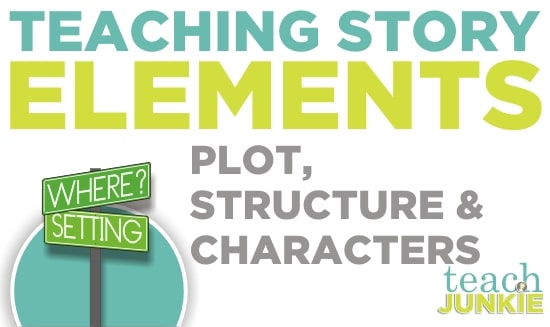Teaching story elements like characters, setting and plot are key to teaching key ELA Common Core standards. Let’s look at two graphic organizing worksheets or maps that help students identify what are important story elements. We know that we can create better readers and writers when we help them dissect good literature and learn how to apply the same techniques in their own learning.
What are Story Elements?
Story elements are the key factors that make up or build the story. This includes the characters (the main figures that move the story along in time or space), the setting (the location, place and time) and the plot (the sequence of events). Many teachers in primary grades also would include the main idea as a key story element.

As a teacher, I find that teaching plot structure is key. I have come to realize that if I can get my students to see patterns in fiction literature then there are 3 things that happen:
- they are more successful at inferring and predicting based on other stories they’ve read with similar structure;
- they are more successful in reading beginner level books since they heavily follow a pattern and deviate from the pattern at the end;
- they are more likely to take risks and be successful in writing since they have dissected a model and can attempt to put one together using their own imaginative content.
This goes way beyond looking at beginning, middle and end. We’re talking that in the middle of a story that sometimes you’ll see an ABC pattern repeated 3 times before entering the story like in The Three Little Pigs or that a growing list can involve your readers like in The Little Old Lady Who Wasn’t Afraid of Anything.

This spring themed story map would be ideal to use with any spring story like (affiliate links) Horton Hatches an Egg, The Cow that Laid an Egg, Egg Drop or The Easter Bunny’s Assistant. Students can use drawings and illustrations to pick out the most important parts of the plot on one page or list out the characters, setting, problem and solution on the next. This would work best with first grade. {Free download}

Then take it to the next level with this sketching diagram from Andrea and create the equation to describe a character and their actions. This is a great way for older students to look for evidence in a text to support their opinion which they ultimately give in the last portion of this organizer. This free worksheet was used on a lesson to connect with the book Mr. George Baker. This lesson will carry the concept to third grade for any book that illustrates a character strongly. {Free download}
If you have a tip or activity, upload it to the Teach Junkie Community and include your details {and a link back to your blog if you have more you’d like to share there}. I’ve got your back and will walk you through the whole thing! Thanks to these two teachers for their great ideas and free downloads.
More ELA Ideas:
- Teaching Common Core Non-Fiction – 3 Tips
- 6 Spring ELA Word Work Ideas {Free Download}
- 5 Spring Writing Templates {Free Download}
- 4 Language Arts {Free Download}
- Kindergarten Printable Props for Retelling
Leslie {aka the original Teach Junkie} loves learning new things to make teaching easier and more effective. She enjoys featuring creative classroom fun when she's not designing teacher shirts, making kindergarten lesson plans or planning her family's next trip to Disney World.